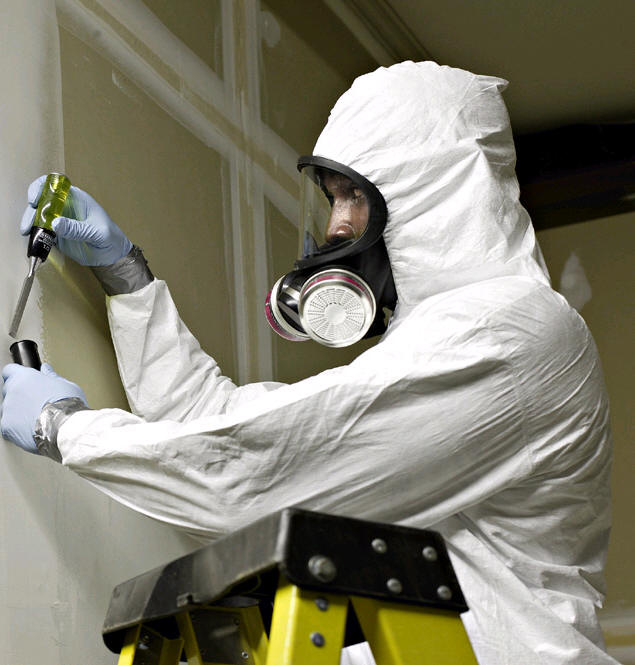Specialist Asbestos Testing: Make Certain Safety and Compliance in Your Home
Specialist Asbestos Testing: Make Certain Safety and Compliance in Your Home
Blog Article
The Complete Refine of Accredited Asbestos Evaluating to Make Certain Building Conformity
In the world of residential or commercial property management and compliance, the procedure of approved asbestos screening stands as a vital component to guarantee the safety and security and well-being of owners. Recognizing the intricate steps included in this testing protocol is paramount for homeowner and managers alike. From the first assessment to the final interpretation of outcomes, each phase plays a crucial function in establishing the presence of asbestos within a residential property. Allow's check out how this precise process unfolds to guarantee adherence to stringent regulations and protect against possible wellness hazards.
Accredited Asbestos Screening: Preliminary Evaluation
In performing the initial evaluation for approved asbestos screening, a precise exam of the home's products is vital to properly determine potential asbestos-containing products. Special focus is given to products that are susceptible to harm or disturbance, as these situations can launch hazardous asbestos fibers right into the air.
Certified asbestos assessors adhere to stringent protocols set by regulatory bodies to make sure the accuracy and integrity of the testing procedure. By meticulously documenting searchings for and using innovative testing approaches, assessors can provide home owners with an extensive report describing the presence of asbestos, if any, and the recommended actions for reduction or removal. This preliminary analysis sets the structure for succeeding actions to attend to asbestos problems and guarantee the security and conformity of the home.
Example Collection Treatments for Asbestos Evaluating
Effective sample collection procedures are necessary in making certain exact asbestos testing results and compliance with regulatory standards. When collecting samples for asbestos testing, it is important to comply with stringent procedures to lessen the threat of contamination and make certain the integrity of the outcomes.
To start with, it is vital to recognize the believed asbestos-containing products (ACMs) and focus on tasting areas based on elements such as the material's condition, ease of access, and potential for disturbance. Asbestos Testing. Examples need to be accumulated from different places within the residential property to supply a detailed evaluation of asbestos presence
Throughout example collection, accredited experts should wear ideal individual safety devices (PPE) to guard against asbestos direct exposure. They must utilize tidy tools, such as non reusable handwear covers and plastic sheeting, to avoid cross-contamination between samples. Examples should be very carefully collected utilizing a defined strategy, such as wet cleaning or coring, and securely sealed in airtight containers to preserve their honesty during transportation to the laboratory for analysis.
Laboratory Analysis Process for Asbestos Examples
Upon conclusion of the sample collection process, the asbestos samples are diligently moved to recognized research laboratories for thorough analysis. The very first action in the laboratory analysis procedure is sample preparation, where the collected samples are meticulously processed to extract the asbestos fibers.

When the analysis is total, an in-depth record is created, outlining the findings and confirming whether asbestos exists, the kind of asbestos fibers determined, and the focus degrees. This details is critical for residential or commercial property owners to take the required steps to make sure conformity with asbestos guidelines and secure the wellness of owners.

Reporting and Analysis of Asbestos Test Outcomes
Accredited asbestos screening research laboratories supply detailed records that provide crucial understandings right into the visibility, kind, and focus degrees of asbestos fibers located in examples gathered from buildings. These reports are crucial for homeowner and managers to understand the risk posed by asbestos and make informed choices concerning its monitoring or elimination. The reports generally include information on the approaches made use of for screening, the places from which examples were taken, the kind of asbestos determined (such as chrysotile, amosite, or crocidolite), and the concentration levels of asbestos fibers spotted.
Translating these outcomes requires proficiency to assess the potential health risks related to asbestos exposure, establish the ideal strategy, and guarantee regulatory conformity (Asbestos Testing). Depending Home Page upon the findings, referrals may vary from proceeded monitoring and upkeep to encapsulation or total asbestos abatement. Homeowner should meticulously evaluate these records and consult with asbestos professionals to establish an extensive strategy Resources for dealing with any kind of asbestos problems identified
Making Sure Residential Or Commercial Property Conformity With Asbestos Laws
To keep adherence with asbestos laws, property proprietors must diligently implement measures to guarantee compliance with applicable laws and standards. This consists of performing normal asbestos assessments by recognized experts to determine any type of presence of asbestos-containing materials within the home. Once asbestos is identified, residential or commercial property proprietors must comply with asbestos monitoring plans that outline correct containment, elimination, or encapsulation treatments to avoid exposure and spread of asbestos fibers. Compliance also entails keeping detailed documents of asbestos screening, maintenance, and elimination activities for inspection purposes.
Homeowner need to offer asbestos recognition training to employees and owners to reduce the threat of asbestos exposure and make sure correct handling of materials that might have asbestos. Additionally, it is critical to stay notified concerning any type of updates or adjustments in asbestos regulations to readjust this contact form administration methods accordingly. By proactively addressing asbestos conformity requirements, homeowner can produce a safe atmosphere for passengers and minimize potential legal and wellness dangers connected with asbestos exposure.
Conclusion
To conclude, approved asbestos testing is an important process for making certain home conformity with guidelines. The initial evaluation, sample collection treatments, laboratory evaluation, and interpretation of outcomes are very important actions in this process. By adhering to these treatments, building proprietors can recognize and address any type of asbestos hazards existing, protecting the health and wellness and safety and security of residents and keeping compliance with regulative requirements.
Report this page